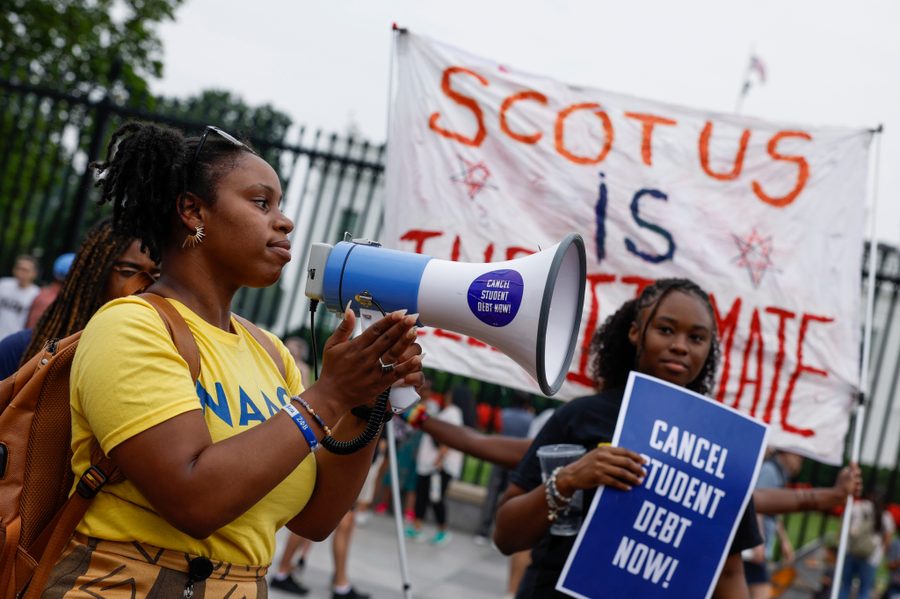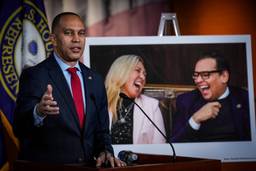If Banks Can Be Bailed Out, Student Debt Can Be Canceled
Biden must act now to make student debt relief a reality—no matter what the Supreme Court says.
Braxton Brewington

Last month, in a hat-trick for right-wing litigants, the U.S. Supreme Court ruled in favor of structural racism, homophobia and mass indebtedness — in that order.
First, the conservative majority struck down affirmative action, ending race-conscious admissions programs for institutions of higher learning. Next, the Court slashed LGBTQ protections, ruling in favor of a plaintiff seeking to refuse services to a hypothetical gay couple. To bring the 2023 session to a close, the Court blocked $10,000 of student debt relief that more than 43 million Americans were counting on in the wake of pandemic-era hardships. According to six right-wing justices, while the HEROES authority grants the Education Secretary power to “waive or modify” student loans in an emergency, President Biden’s debt relief plan was too “significant” to be what Congress intended.
Just a year after overturning Roe v. Wade, these rulings serve as a stark reminder that this Court is on a warpath against the rights and freedoms Americans gained over decades of progressive political change.
In a press conference after the student debt ruling, a reporter asked Biden if this was a “rogue” Court. He hesitated, and then responded solemnly, “This is not a normal court.”
He’s not wrong, in the sense that judges don’t normally take luxurious gifts from billionaires with ties to the cases before them. But as for the radical decisions this Court has handed down, abnormality as a descriptor doesn’t go far enough. Justice Elena Kagan made it plain in her dissent: the ruling on student debt “violated the constitution.” To even hear the case in the first place, she wrote, “exceed[ed] the permissible boundaries of the judicial role.”
There’s another way the decision wasn’t normal. Typically a party seeks to remedy a concrete injury that they themselves suffered. But in Biden v. Nebraska, six Republican-controlled states sued on behalf of student loan servicer MOHELA, claiming that a loss of financial revenue to MOHELA harms the state of Missouri. The Court generally doesn’t “allow plaintiffs to rely on injuries suffered by” third parties. That’s one of the basic limits on federal judicial power. But this tenuous and debunked claim of financial harm was deemed sufficient to undo Biden’s initial iteration of student debt relief.
In a Roosevelt Institute report I co-authored, myself and fellow researchers revealed that after Biden’s student debt relief plan would have been implemented, MOHELA would earn more revenue than ever before — a direct contradiction to the Republicans’ claim that revenue would be cut nearly in half. How did such a flawed claim squeeze by the Supreme Court’s fact finding process? Well, they didn’t have one. In granting certiorari before judgment through the shadow docket, no court ever conducted a discovery — the legal procedure in which someone at the Court reviews the evidence. Every step of the way, Republicans’ lies were taken for truth.
To put it plainly, Republicans sued to stop Biden’s student debt policy simply because they didn’t like the policy. But we already have a process where grievances like these can be sorted — we call them elections. Now, if you’re a Republican that can place a bogus lawsuit before a sympathetic judge, you don’t need to make your case to voters, because the politicians with gavels and robes will decide on these issues instead.
It’s no wonder confidence in the Supreme Court is at a historic low, with more than half of Americans saying they want it to be structurally reformed. That will require a tectonic shift in the legislative branch — which is past due for major reforms itself. Until then, the executive branch can’t let the Supreme Court have the last word on such consequential issues. President Biden needs to be willing to act in the name of justice just as boldly as the Court is willing to undermine it.
Thanks to relentless grassroots pressure since the legal challenges to relief began, Biden announced he would take another go at student debt relief, this time by invoking the Higher Education Act — the exact authority advocates like the Debt Collective and progressive congress members have pushed for years. But still, he’s slow-walked the execution, and the White House has admitted that relief “could take some time.” Worse, he’s moving forward with resuming payments in the fall, inevitably harming the exact low-income borrowers whose debts he promised to cancel.
It doesn’t have to be this way. The Biden administration can and must implement student debt relief right away, acting swiftly before Republicans can concoct another frivolous legal challenge. Organizers are already working to push the White House to act fast.
We know it can be done. When Silicon Valley Bank crashed earlier this year, President Biden saved the bank and its financial investors within 72 hours. There was no political grandstanding over whether Section 13(3) of the Federal Reserve Act provided the authority to bail out venture capitalists. No internal hemming and hawing over whether negligent bank runs warranted “unusual and exigent circumstances.” There was just action.
It’s that sense of urgency and unwavering support that the Biden administration must now treat another constituency that’s too big to fail — over 43 million student debtors.
As Sen. Bernie Sanders (I-Vt.) put it, if the Supreme Court wants to “quit and run for office” on their extremist views, let them. But while they’re still one of the three branches of government, the other two must intervene.

I hope you found this article important. Before you leave, I want to ask you to consider supporting our work with a donation. In These Times needs readers like you to help sustain our mission. We don’t depend on—or want—corporate advertising or deep-pocketed billionaires to fund our journalism. We’re supported by you, the reader, so we can focus on covering the issues that matter most to the progressive movement without fear or compromise.
Our work isn’t hidden behind a paywall because of people like you who support our journalism. We want to keep it that way. If you value the work we do and the movements we cover, please consider donating to In These Times.
Braxton Brewington is a community organizer and spokesperson for the Debt Collective.



